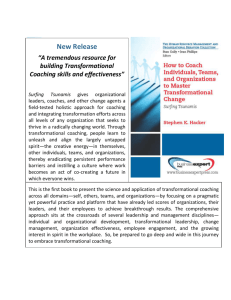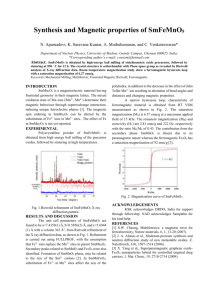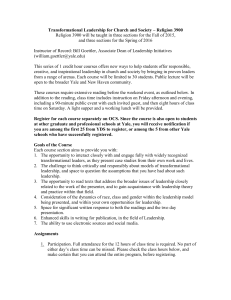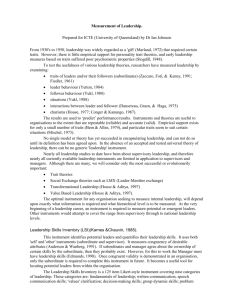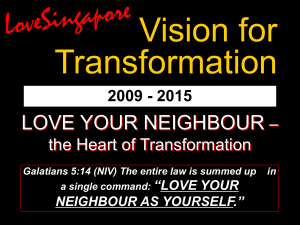Transforming Leadership
advertisement
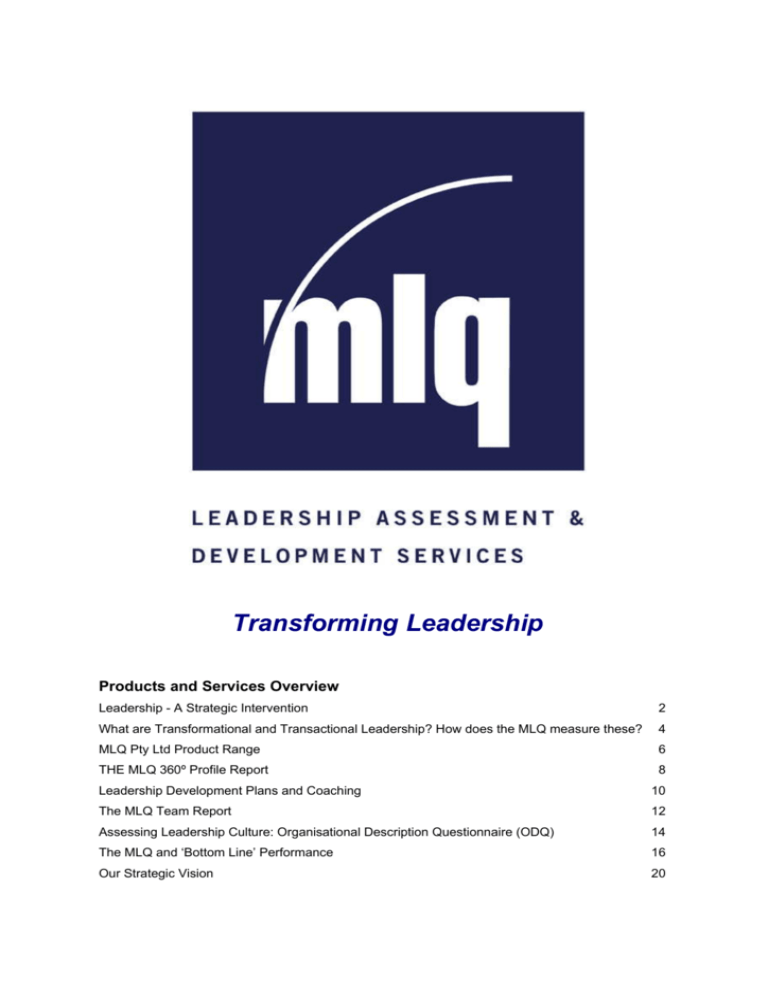
Transforming Leadership Products and Services Overview Leadership - A Strategic Intervention 2 What are Transformational and Transactional Leadership? How does the MLQ measure these? 4 MLQ Pty Ltd Product Range 6 THE MLQ 360º Profile Report 8 Leadership Development Plans and Coaching 10 The MLQ Team Report 12 Assessing Leadership Culture: Organisational Description Questionnaire (ODQ) 14 The MLQ and ‘Bottom Line’ Performance 16 Our Strategic Vision 20 LLeeaaddeerrsshhiipp -- A AS Sttrraatteeggiicc IInntteerrvveennttiioonn Leadership training is not just about developing individuals Leadership training should not be seen as just a matter of developing individuals. The most powerful interventions focus simultaneously at the individual, group and organisational levels. The interaction effects between these multiple levels should be harnessed to achieve the maximum support for enhancing leadership. Consequently The best leadership training is a strategic intervention at multiple levels – individual, group and organisation. Changing people’s behaviour and the way they see themselves and their work environment takes time. There will be “catalytic events” which stand out as critical points in individual, group and organisational development. But these kinds of changes do not take place overnight. Clients should be cautioned about expecting the “quick fix”. Rather, they should think in terms of six months or more. Consequently – The best leadership training has an impact on personal and organisational development which takes time. Too many training strategies focus on the one day workshop – offsite. These have been shown to be of limited value. The highest impact training is on-the-job training alongside management and staff which is customised to the particular requirements of the people in an organisational context. Consequently – The best leadership training takes place within an organisational context and it should be should issue-based / problem focused. The MLQ is supported by a comprehensive follow-through Full Range Leadership Coaching training package which fosters leader development. This training focuses on the establishment of individually customised Leadership Development Plans (LDPs). These plans can either be self-driven by the leader or produced through consultation with an Accredited MLQ Full Range Leadership Coach. Such a commitment to leadership training and development is a feature of the total approach to MLQ assessment and training services. An Example of Leadership Development Strategy at Multiple Levels Identify those group and individual behaviours which relate to desired outcomes Assess the frequency with which the full range of leadership behaviours is exercised within the leadership group, and by individual members in the organisation Provide structured feedback to leadership group members - individually, and appropriately at the leadership group level Establish a leadership development plan for each individual Establish an appropriate group and organisational development process The leadership group feedback is about: - the group’s own self-ratings how other people (in the organisation and beyond it) rate the leadership group using the Full Range Leadership Model. Establish a process for individual, group and organisational development in light of this feedback. 2 From Distinguished Professor Bruce Avolio: Are Leaders Born or Made? This question comes up again and again in almost every workshop I’ve ever conducted around the world. I often wonder why people are at leadership training workshops, if they truly believe that leadership is born not made! It is probably not a voluntary choice for them. Over the last ten years, there have been 5 studies that have examined whether transformational leadership can be enhanced through training. The good news is that in each and every study, there was a positive impact on transformational leadership development. The even better news is that the last two studies were rigorous true field experiments, and in both of these investigations there were significant improvements in transformational leadership behaviours, as seen by followers versus just in one’s self ratings. Let me summarise briefly what appeared to have the leadership styles to be more transformational in these respective investigations: • Having a clearly stated goal concerning the leadership style one wants to work on, a specific way to evaluate progress towards the goal, and support in the form of one to one coaching. • Extending training over time using “booster sessions” one and two months out, not only appears to sustain enhancements to transformational leadership development, but also increases the impact of initial training. • Providing participants with MLQ 360 feedback and identifying both strengths and areas for development, which can be included in development planning. • Offering support from one’s peer group following training for consultation and advice. • Presenting a coherent model of leadership, which we refer to as Full Range Leadership TM , seems to be a major factor in facilitating participant’s reflective learning capacity and ability to develop transformational leadership style over time. In summary, these five areas appeared to be the main factors that impacted on transformational leadership development and demonstrated support for the idea that leadership indeed can be developed. 3 W Whhaatt iiss TTrraannssffoorrm maattiioonnaall aanndd TTrraannssaaccttiioonnaall LLeeaaddeerrsshhiipp?? H MLLQ Qm meeaassuurree tthheessee?? Hoow w ddooeess tthhee M * Please note, the constructs of transformational and transactional leadership presented here to form the Full Range Leadership Model are copyright to Bernard M. Bass & Bruce J. Avolio. Transformational Leadership Transformational leadership is a process of influencing in which leaders change their associates awareness of what is important, and move them to see themselves and the opportunities and challenges of their environment in a new way. Transformational leaders are proactive: they seek to optimise individual, group and organisational development and innovation, not just achieve performance "at expectations". They convince their associates to strive for higher levels of potential as well as higher levels of moral and ethical standards. Transformational leadership does not replace transactional leadership, but augments it in achieving the goals of the group. The MLQ assesses transformational leadership with the following five subscales: The five subscales of Transformational Leadership measured by the MLQ 360: Idealised Attributes (IA): Builds trust, confidence and attracts a following. Idealised Behaviours (IB): Builds trust, confidence and attracts a following. Inspirational Motivation (IM): Raises expectations and beliefs concerning the mission/vision. Intellectual Stimulation (IS): Challenges old assumptions and stimulates idea generation. Individualised Consideration (IC): Determines individual needs and raises them to higher levels. 4 Transactional Leadership Transactional leaders display behaviours associated with constructive and corrective transactions. The constructive style is labelled Contingent Reward and the corrective style is labelled Management-by-Exception. Transactional leadership defines expectations and promotes performance to achieve these levels. Contingent Reward and Management-by-Exception are two core behaviours associated with 'management' functions in organisations. Full range leaders do this and more. The MLQ assesses transactional leadership with the following two subscales: The Subscales of Transactional Leadership - measured by the MLQ 360: Contingent Reward (CR) Clarifies objectives and exchanges rewards for performance. Management by Exception: Active (MBE-A): Takes corrective actions when mistakes occur - leaders systematically monitor mistakes and deviations for standards and take corrective action when mistakes occur. Passive / Avoidant Leadership Another form of Management-by-Exception leadership is more passive and "reactive": it does not respond to situations and problems systematically. This style is has a negative effect on desired outcomes - opposite to what is intended by the leader - manager. In this regard it is similar to laissezfaire styles - or "no leadership". Both types of behaviour have negative impacts on followers and associates. Accordingly, both styles can be grouped together as 'Passive - Avoidant Leadership'. The MLQ assesses non-leadership with the following subscales: The subscales of Passive / Avoidant Leadership - measured by the MLQ 360: Management by Exception: Passive (MBE-P): Takes corrective actions when mistakes occur – leaders only intervene to make corrections when something goes wrong. They do not search for mistakes. Laissez-Faire (LF): Inactive or laissez-faire leadership is the absence of leadership, the avoidance of intervention, or both – not around when needed. 5 FFuullll R Ovveerrvviieew Raannggee LLeeaaddeerrsshhiipp M w Mooddeell ((FFR RLLM M)) O The Full Range Leadership Model (FRLM) is the research supported theoretical base for the MLQ, MLQTeam and ODQ. The FRLM describes a full range of influencing styles from ‘non-leadership’ to powerful transformational leadership behaviours. The model captures different kinds of behaviours which make a difference to outcomes for associates of the leader. Transformational leadership behaviours have been shown to powerfully augment most traditional or ‘transactional’ leadership behaviours. Transformational behaviours change the perception of followers and associates and produce stronger extra effort, satisfaction, efficiency and productivity outcomes. Core to the FRLM are two inter-related competencies: The first concerns whether the leader has the full repertoire of leadership styles in the first place - both transformational and transactional behaviours. i.e. does the leader recognise what is important in getting the best results from others, and can the leader behave in these styles when he/she chooses to do so? The second concerns the balance with which the leader exercises these behaviours over time i.e. the frequency with which he/she exhibits each of the full range of leadership styles. Both competencies are important to achieve optimal outcomes such as satisfaction, extra effort and efficiency with followers and associates. Full Range Leadership Model © Bass and Avolio, 1997 6 M MLLQ QP Pttyy LLttdd P Prroodduucctt R Raannggee Instruments Assessing the Full Range Leadership Model • Personal MLQ 360° Report The world research benchmark on a full range of leadership styles – transformational, transactional and passive-avoidant. Optimum research-based behaviour frequencies linked to outcomes. Internetbased, email and paper platforms for data-management. Typically between 10 and 24 raters. • Leadership Development Plan Dedicated leadership plans based on MLQ report established using the Leadership Notebook Resource or on-screen Microsoft Excel® version. The framework for on-going coaching to optimise leadership profile. • MLQTeam Report Measurement of the internal behaviours exhibited by team members. Reports internal team behaviours in terms. Ideal for benchmarking pre-post team training. Companion to the 360 MLQ. • Organisational Culture (ODQ) Report Measurement of the two higher-order constructs of the Full Range Leadership Model – Transformational and Transactional. Assesses the style and coherence of leadership culture. Supplementary Products • Mentor-Mentee Report Measures important aspects of the Mentor-Mentee relationship from both the Mentor and Mentee perspectives. Two mirror-reports which help both optimise the effectiveness of the relationship. • Network Resource Folder Pre-packaged training notes, Powerpoint® slides, and participant sheets for running your own workshops. Ideal for conducting feedback and training workshops for client organisations and groups for 1-1½ days. Incorporates MLQ assessments. For use only by accredited MLQ persons. Training • Organisational Workshops in Full Range Leadership Offered by MLQ Direct or by Accredited MLQ Network Members and MLQ Consultants. Customised to the needs of the client organisation. On-the-job training combined with coaching. • MLQ Accreditation Courses Four courses based on the Instruments above over ½ or full days in most Australian States. Include extensive support materials, research readings, and a competency test for satisfactory completion. In-house (within an organisation) or international workshops also run by request. MLQ Coach - Consultants MLQ works with accredited MLQ Consultants and Coaches around Australia, New Zealand, Singapore and in Europe. Competent professional services often driven by IO Psychologists. 7 TThhee M MLLQ Q 336600ºº P Prrooffiillee R Reeppoorrtt Multifactor Leadership Questionnaire (MLQ) by Bernard Bass and Bruce Avolio The Multifactor Leadership Questionnaire is a short but comprehensive survey of 45 items which measures a full range of leadership styles. The revised MLQ 5x has strong validity and reliability and has been used extensively in research and commercial applications worldwide. It has proven to be a strong predictor of leader performance across a broad range of organisations at different organisational levels and in different national cultures. The MLQ provides for 360-degree measurement of a leader / manager with anonymous reporting facilitated by accredited persons internal or external to an organisation. Responses are gathered from the individual being surveyed and from associates at a higher level, same level, and a lower level. An additional 'other' group may also be utilised. Numbers of raters typically range between ten and twenty-four in any given report. Responses are confidentially collated into an extensive report that helps leaders understand their scores. The MLQ 360 Profile Report is an excellent assessment tool for personal and professional development and associated coaching. Accredited MLQ Facilitators and MLQ Full Range Leadership Coaches are equipped to implement the entire 360 process and coaching follow-through to the highest ethical and professional standards. Additional one-on-one independent external coaching with an expert MLQ Full Range Leadership Coach optimises the benefits of this measurement and feedback process. At least one such coaching session is a precondition for receiving a MLQ Report. This session of approximately one and a half hours enables reception and accurate interpretation of the structured feedback provided by the MLQ Report. *(See, for example, Bass, B.N. Does the Transactional-Transformational Leadership Paradigm Transcend Organisational and National Boundaries? American Psychologist, February, 1997. Vol 52, No. 2) Subscales of the MLQ Transformational Leadership Transactional Leadership Idealised Attributes Contingent Rewards Idealised Behaviours Management-by-Exception (Active) Inspirational Motivation Intellectual Stimulation Individualised Consideration Passive / Avoidant Leadership Outcomes of Leadership Management-by-Exception (Passive) Extra Effort Laissez-Faire Effectiveness Satisfaction 8 MLQ 360º Profile Report Features Brief overview of the Full Range leadership Model (FRLM) by Bass & Avolio, 1995 Full descriptions of the leadership styles and outcomes with raters Listing of key research findings on Transformational Leadership and the FRLM Optimal behaviour frequency ranges, based on research outcomes included in profile graphs Graphical reporting of the results for each of the 9 FRLM factors and 3 outcomes scales, both aggregated, and relative to organisational level Comparison with up to 3 Norms - Global, Australian (or country) aggregate, market segment or within current organisation Top 6 strengths in Transformational Leadership styles (specific to each Leader profile) Top 6 areas for Transformational Leadership development (also specific to the Leader) Self-Rater gap analysis - Leaders are compared across the 9 factors with all other Raters in each group graphically for difference rating 3 Open-response fields for unique Rater Comments regarding i. What is admired about the Leader ii. What gets in the way of their leadership iii. How Leaders can improve their effectiveness Full reporting of all data Individual planning and goal setting, and information on ‘Making the most of your MLQ Report’ (consistent with MLQ Accreditation training) 9 LLeeaaddeerrsshhiipp D Deevveellooppm meenntt P Pllaannss aanndd C Cooaacchhiinngg Coaching managers and executives is a specialised form of leadership coaching. It takes place within a broader set of skills methodologies and knowledge that comprise the current field of generalist coaching (Elliott, 2003*). Explore cognitive and behavioural coaching methods for leadership development utilising reliable theories and methods that count. This course explores generalist coaching and the kinds of knowledge and methodologies required for specialist leadership coaching . It particularly focuses on the well-established Full Range Leadership Model (Bass and Avolio) and trains participants in how to work with this empirically-supported, outcomes-driven, framework to achieve optimal results for the coachee and their organisation. Receiving an MLQ or MLQTeam Assessment Report provides the basis for on-going coaching, training and development plans for individual leaders or a group. Accredited MLQ Full Range Leadership Coaches are trained to produce dedicated and effective group and individual Leadership Development Plans (LDPs) efficiently and in a cost-effective manner. Leaders may, in part, be born. But they are certainly also made through combined internal and external coaching based on the solid Full Range Leadership Development Model (™Bass and Avolio) to achieve performance beyond expectations. Too often staff and management development stops at assessment and neglects the development of leaders in an organisation. Simply sending them to external “off the shelf” workshops has been shown to be of limited value (e.g. The Karpin Report). However, dedicated on-the-job training through: professional coaching partnerships; the establishment of effective coaching “boosters” within each organisation; the Full Range Leadership Model; and individually-tailored leadership development plans provides superior return on investment and proven training effectiveness. For individual leaders, an LDP is established in two sessions following each leaders’ initial session to receive feedback from the MLQ 360º Profile Report. Based on the objectives for leadership development arising from that MLQ assessment, an LDP unique to each leader is presented to and discussed with each leader by the MLQ Full Range Leadership Coach. The LDP is presented to each leader under key headings reflecting salient relevant factors of the Full Range Leadership Model which will help achieve maximum leverage for leadership development. In this session the LDP is reviewed and organised in ways which suit the learning style and preferences of person: this is essential if the plan is to be fully and effectively implemented. The key principle driving this consultation process is that the leader must “own” for themselves the items they have selected for their own development based on the MLQ Report – this then enables ease of access to these items by each leader. Leaders also select several appropriate internal enabler support persons (IESPs). These are persons within the organisation who can assist the leader to achieve their own development goals through the provision of routine feedback and constructive suggestions. Once a Leadership Development Plan is in place, with appropriate informed consent of the persons involved, the twin concerns of assessment for development and assessment for appraisal can be merged without undermining the value and authenticity of each purpose for assessment. The LDP can then inform Key Performance Indicators and parts of it incorporated into these performance criteria. 10 The combination of regular on-going meetings approximately monthly with an external Accredited MLQ Full Range Leadership Coach and routine feedback from IESPs operate to become important “boosters” assisting a leader’s development. These motivators are often more important than traditional performance incentives based on $ remuneration. Through such coaching boosters, leaders are assisted to move from experimenting with the application of new behaviours and understanding to adopting these as a normal part of their repertoire. In this way they achieve unit and organisational performance beyond expectations. These movements in leadership improvement usually take between four and nine months before they become embedded in the leader’s thought processes and behaviours. Dedicated leadership training and individual LDPs work best when they are accompanied by leadership development interventions at multiple levels – individual, group and organisation-wide. The Leadership Development Cycle The Leadership Development Cycle is a model which MLQ Full Range Leadership Coaching uses in the leadership development process. MLQ Full Range Leadership Coaching makes use of powerful internal-enabler support networks to assist individual leadership development. These are part of the “boosters” shown in the diagram below. Leadership Development Cycle Level 1: Awareness Level 4: Advancement / Achievement 1. Challenge self image Identification & alignment with mission/vision 2. Introduce Full Range Leadership Model Developing to Full Range Potential Revert back 3. Examine personal models & other models Level 2: Application Disillusionment Internalisation: Learn to improve & develop style 4. Create a development plan No support /inhibit 7. Reinforcement from: self and others 5. Exhibit behaviours & track Level 3: Adoption Booster 6. Impact on others Common break-point Comments: Most Leadership Development Efforts involve I & II Development impact depends on critical transition /booster Change in internal perspective must eventually align with external opportunities /constraints /perspectives Critical Transition: Impact of Organisational Constraints/ blockages Adapted from Empowerment Cycle, Quinn 1996) 11 TThhee M MLLQ Q TTeeaam mR Reeppoorrtt The MLQTeam is a very useful instrument for benchmarking, through internal member ratings and the team’s internal leadership behaviours. As such it provides a yardstick against which to diagnose current team performance and measure future improvements as a consequence of team enhancement strategies. The MLQTeam is based on the thoroughly researched Full Range Leadership Model (™ Bass & Avolio) which differentially links a full range of leadership behaviours with outcomes such as satisfaction, extra effort, efficiency and performance beyond expectations. The FRLM has nine leadership factors grouped into Transformational, Transactional and Passive / Avoidant behaviours. The MLQTeam provides an excellent opportunity to educate all team members about the FRLM. This can be a useful first step before having team members undertake the sometimes personally challenging 360-degree feedback using the Multifactor Leadership Questionnaire (MLQ). The MLQTeam compliments the Multifactor Leadership Questionnaire by providing and reinforcing at the group and organisational levels what the MLQ provides at the individual level. The MLQ is arguably the most researched leadership instrument in the world. It has been used in hundreds of applied business and pure research studies and is the subject of extensive published literature in leading international journals. The MLQTeam is often a good place to start with a work group since it affords the opportunity to educate a group about the Full Range Leadership Model. In addition it provides valuable feedback to the team as a whole about how its members see the group performing leadership functions as a team. Like the MLQ, the MLQTeam's dimensions include: Transformational Leadership, Transactional Leadership, Passive / Avoidant Leadership, and outcomes of leadership such as ratings of effectiveness, satisfaction and efficiency. Responses from the MLQTeam are gathered from all team members and the results are aggregated for the whole group. These are then reported in a comprehensive Multifactor Leadership Questionnaire for Teams Report comprising 20 pages: 12 MLQTeam Report Features Brief overview of the Full Range leadership Model (FRLM) by Bass & Avolio, 1995 Full descriptions of the leadership styles and outcomes with team members Listing of key research findings on Transformational Leadership and the FRLM Optimal behaviour frequency ranges, based on research outcomes included in profile graphs Graphical reporting of the results for each of the 9 FRLM factors and 3 outcomes scales, both aggregated, and relative to organisational level Comparison with Australian aggregate norms Top 6 strengths in Transformational Leadership styles (specific to Team profile) Top 6 areas for Transformational Leadership development (also specific to the Team) Pattern of scale responses Graphical representation of Group Agreement across leadership styles Full reporting of all data Team planning and goal setting 13 A Asssseessssiinngg LLeeaaddeerrsshhiipp C Cuullttuurree:: O Deessccrriippttiioonn Orrggaanniissaattiioonnaall D Q OD DQ Q)) Quueessttiioonnnnaaiirree ((O The Organisational Description Questionnaire (ODQ) is a diagnostic tool for measuring perceptions of team, departmental and organisational culture. The questionnaire is based on the distinction between the Transactional and Transformational paradigms in leadership styles reflected in the FRLM and measured by the MLQ / MLQTeam. The ODQ provides a useful and efficient way of benchmarking both the transactional (management) and transformational (leadership) influencing styles characteristic of an organisation. The findings are presented as a scattergram with transactional ratings (-14 to +14) on the horizontal axis and transformational ratings (-14 to +14) on the vertical axis. The report includes means and standard deviations for these scales and plots the “most common tendency” against a background of nine characteristic organisational cultures: Transformational +14 0 Maturing Highly Developed High Contrast Loosely Guided Coasting Formal Garbage Can Pedestrian Bureaucratic -14 -14 0 +14 Transactional The ODQ questionnaire consists of 28 statements requiring the respondent to allocate a 'true', 'false' or 'uncertain' rating for their team or organisation culture. It is easily completed by organisation members in several minutes electronically or on paper. An unlimited number of organisation members can participate in an ODQ Report. All participants can be divided into up to 10 sub-divisions. Means and standard deviations for each of these sub-divisions are calculated and plotted against the overall Organisational figures. Normative data for Australia is presently available for comparison. 14 ODQ Report Features Brief overview of Transformational and Transactional Cultures Listing of key research findings on Transformational Leadership and the FRLM Plot of Organisational Leadership Culture profile - including up to 10 sub-divisions Text profile of Organisational Leadership Culture Comparison with Australian aggregate norms Scattergram of all data: Leadership Culture Coherence Graphical ranking of Transformational and Transactional items Full reporting of all data Utilising the ODQ: Benchmarking, mapping variations, diagnostics Change intervention Plan 15 TThhee M MLLQ Q aanndd ‘‘B Boottttoom m LLiinnee’’ P Peerrffoorrm maannccee Malcolm R. Davies Perhaps the major advantage of the MLQ is that it validly and reliably measures managerial behaviours that are related to performance. Many instrument marketers make this claim. When asked they can’t show impartial objective evidence to back their claims. No other instrument, that I am aware of, has been independently shown to measure behavioural factors (the 5 I’s) that correlate with both follower and organisational measures of performance. Perhaps the ones of most interest to client organisations are the organisational measures, so lets briefly review some of the MLQ evidence linking higher ratings on the 5 I’s to better bottom line performance. Agle (1993) studied 250 US major company CEOs. Follower ratings of transformational leadership behaviour factors correlated with organisational sales increases, market share, earnings and ROI. Carless, Mann and Wearing (1995) showed that scores on transformational leadership factors predicted both individual and group performance in a large study of middle level managers in a large Australian bank. Garcia (1995) found that supervisor rated transformational leadership scores of sales people accounted for 37% of the covariance in their sales performance. The higher their transformational behaviour ratings the better their sales performance. Coleman, Patterson, Fuller, Hester and Stringer (1995) conducted a meta analysis of 27 studies. They found that transformational leadership ratings explained between 45% and 60% of organisational performance across the studies. Barling, Weber and Kelloway (1996) showed that transformational leadership training and coaching of bank branch managers over time improved follower ratings of transformational leadership. Bank branches run by the trainees improved performance significantly in comparison with a control group. Lowe, Kroeck and Sivasubramaniam (1996) conducted a meta analysis of 47 studies in which a relationship between transformational leadership ratings and organisational performance had been assessed. For both public and private organisations transformational leadership ratings were strongly related to organisational performance measures. Geyer and Steyrer (1998) found that units of a German bank where managers were rated by followers as more transformational ran units that had higher bottom line performance. In the studies above I have not included studies by Bass and Avolio themselves since it is common for studies by the test authors themselves to be discounted as not being impartial. The studies above and many others show that, in marketing the MLQ as a powerful tool for helping organisations improve bottom line performance, we are on very solid ground indeed when we claim: The MLQ measures managerial behaviours that are strongly related to bottom line performance, The MLQ applies across cultures, and industries and in the public sector, The MLQ can be used as the basis of transformational leadership development on the job which works and has been shown to improve organisational performance, The MLQ, when used periodically (4 to 12 month cycle), is an excellent tool to assist learning during coaching by providing an objective measure of developmental improvement. 16 C Coonnvviinncciinngg S MLLQ QM Mooddeell Suuppppoorrtt ffoorr tthhee 99--FFaaccttoorr M The Festschrift of Dr. Bernard Bass attracted many scholars who “paid their dues” to Bass for his voluminous and important contributions to the leadership field, and many of the talks centred on Bass’s theory of transformational leadership. The first session was delivered by Dr. Robert House from the Wharton School of the University of Pennsylvania, and Dr. John Antonakis from the Psychology Department of Yale University. House summarized the full range of leadership model, as measured by Bass and Avolio’s MLQ, and discussed the major propositions of the theory. House also showed how the model related to other major theoretical frameworks and demonstrated how future leadership models may be centred around the transformational, transactional, and passive / avoidant leadership model of Bass and Avolio. Antonakis presented the latest findings on the validity of the model, and concluded that the ninefactor model of the full range theory—as measured by the MLQ5X—is best represented by nine single-order factors as Bass and Avolio originally contended. Antonakis integrated data from 18 studies (n=6,525) and used powerful confirmatory factor analysis techniques to test the nine-factor model against other models that some researchers claimed were more accurate representations of the theory. Antonakis found that given the contextual nature of leadership, the MLQ model varied depending on moderating conditions which included various environmental and organizational settings, leader gender, and the hierarchical level of the leader. When testing the model in samples from similar contextual settings, the nine-factor model always appeared to best represent the data. These results led Antonakis (2001) to state that “based on the evidence provided, it can be concluded that the nine-factor model underlying the MLQ 5X should be retained for future leadership research” (p. 219). He mentioned further that practitioners should “support leadership research efforts, sponsor research efforts, commit to ongoing leadership training, and fund continued testing of the MLQ and the full-range model of leadership” (p. 251). Reference: Antonakis, J. (2001). The validity of the transformational, transactional, and laissez-faire leadership model as measured by the Multifactor Leadership Questionnaire (5X). Dissertation Abstracts International, (University Microfilms No. 3000380). 17 TThhee LLiinnkk w wiitthh O Ouuttccoom meess Everybody has an idea about what an effective leader is and what it is that they do to have this impact on others. But the research behind the Full Range Leadership Model (FRLM) has helped us to focus on those particular behaviours which have been shown to make a difference to outcomes on associates. Some behaviours have been shown to have a negative effect, others a positive effect, and others again have a strongly powerful positive effect. The FRLM assists us to know with confidence where the “goal posts are” for behaviour change. It is not just a matter of individual opinion – but of scientifically-directed research. This is the foundation upon which the FRLM is built. It spans hundreds of independent research studies. The link with outcomes is one of the strongest credentials of the FRLM and the instruments used to measure it, such as the MLQ. Outcomes of Leadership for Individuals Extra Effort Get others to do more than they expected to do Heighten others’ desire to succeed Increase others’ willingness to try harder Effectiveness Effective in meeting others’ job-related needs Effective in representing their group to higher authority Effective in meeting organisational requirements Leads a group that is effective Satisfaction Uses methods of leadership that are satisfying Works with others in a satisfactory way Additional Outcomes of Leadership for Teams Shared Purpose Team members set high standards Team members envision exciting new possibilities Team members talk optimistically about the future Team Members talk enthusiastically about our work Increased Commitment To the group and each member of it To the groups agreed mission and purpose Increased Trust Greater honesty within the group 18 More direct communication about important matters A positive acceptance of difference More Drive Positive energy freed up Clearer focus Fewer interpersonal obstacles Key Research Articles 1. Avolio, B.J. (1996). What’s all the karping about down under?: Transforming Australia’s leadership systems for the twenty-first century. In K.W. Parry (Ed.) Leadership research and practice: Emerging themes and new challenges. Victoria: Pitman. 2. Barling, J., Weber,T., & Kelloway, E. K. (1996). Effects of transformational leadership training on attitudinal and financial outcomes: A field experiment. Journal of Applied Psychology, 81 (6), 827-832. 3. Bass, B.M. (1997). Does the Transactional-Transformational Leadership Paradigm Transcend Organisational and National Boundaries? American Psychologist, 52 (5), 130-139. 4. Bass, B.M. & Avolio, B.J. (1993). Transformational Leadership: A response to critics. In M.M. Chemers, & R. Ayman. (Eds.). Leadership theory and research: Perspectives and directions. Sydney: Academic Press Inc. 5. Howell, J.M., & Avolio, B.J. (1993). Transformational leadership, transactional leadership, locus of control, and support for innovation: Key predictors of consolidated business unit performance. Journal of Applied Psychology, 78 (6), 891-902. 6. Lowe, K.B., Kroeck, K.G., & Sivasubramaniam, N. (1996). Effectiveness correlates of transformational and transactional leadership: A meta-analytic review of the MLQ literature. Leadership Quarterly, 7 (3), 385-425 19 O Ouurr S Sttrraatteeggiicc V Viissiioonn Our slogan, Transforming Leadership, captures the essence of MLQ Pty Ltd - the implementation of seven transforming intentions: Transforming the current “leadership industry” by providing products and services with a demonstrated basis for improving performance outcomes in organisations based on accurate and valid assessments of behaviours shown to “make a difference”. Transforming Australian management’s view about the relevance of solid research to leadership practices in organisations and promoting transparency in commercial (as well as academic) leadership research. Transforming people’s understanding of leadership by assisting them to think about behaviours which can be learnt as distinct from mere qualities or personality characteristics (which people often suspect cannot be developed). Transforming leadership to establish a full repertoire of leadership behaviours and achieve appropriate balances in the use of this repertoire over time with followers and associates. Transforming leadership by integrating best practice leadership theory, models and insights in serving the development of individuals and organisations. Transforming the leadership training industry by seeking opportunities to rigorously evaluate the effects of the interventions we undertake. Transforming the impact of direct leadership to achieve a smarter workforce engaged in a more dynamic environment through e-based technologies, economies and knowledge based systems. Ray Elliott, Director 20
